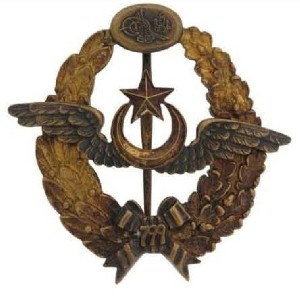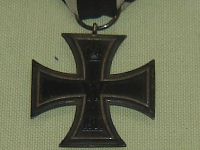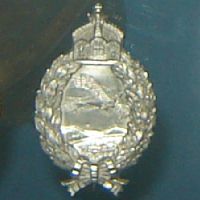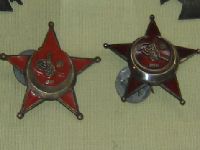|
German
Pilots in the Ottoman Empire 1914-18
|
|
 |
 |
 |
 |
 |
|
Figure 1
Pilot
Jagdstaffel 4
France 1916 |
Figure 2
Pilot
Flieger Abteilung 304(b)
Palestine 1917 |
Figure 3
Officer
Flieger Abteilung 300
Palestine 1917 |
Figure 4
Pilot
Flieger Abteilung 300
Palestine 1917 |
Figure 5
Pilot
Flieger Abteilung 300
Palestine 1917 |
Uniforms of German pilots in the Ottoman Empire
in the First World War
As on the European Fronts, the uniforms worn by pilots of the Imperial
German army were highly irregular and it is unusual to see any two
dressed similarly. Many wore the 1910 field grey
uniforms of their previous regiments (see
German Field Grey Uniforms)
and some wore Ottoman officers uniforms (see
Ottoman Army Uniforms).
In Palestine from 1916 onwards, khaki or white
tropical uniforms (see Asienkorps Tropical Uniforms Page)
were worn.
Many pilots
wore a combination of these uniforms. While flying, German pilots in Palestine usually wore the same apparel
as seen in Europe- flying helmets, goggles, and often non-regulation
leather jackets over their uniforms.
The Illustrations
|
Figure 1 is based on a
photograph of the German Pilot, Hauptmann Hans-Joachim Buddecke.
As in most
photos of Buddecke, he wears a privately tailored Ottoman pilots
uniform (see
Ottoman Army Uniforms) in olive green with six buttons down the front, hip pockets
and two cuff buttons. The standing collar is in arm-of-service colour
(red for air service), as is the backing of the gold officer's
shoulder strap. His headgear is an Ottoman officers "Kalpak" (lamb's wool
hat) with a wide brass badge featuring a crescent and star with flying wings (similar the design in the centre
of the pilot's badge- see right) across the front. Buddecke seems to
have liked this uniform and continued to wear it even when posted back to
the Western Front (where the photograph upon which this illustration
is based may have been taken).
At his throat he wears the Pour Le Merité medal, Prussia's highest
award. On his left breast he wears what appears to be an Ottoman Liakat
silver medal with an Ottoman pilot's badge (see right) and an Iron Cross
first class (see Medals Page).
| |
Hauptmann Hans-Joachim Buddecke
(1890-1918), nick-named "The Hunting Falcon", had originally served as
an officer in the 115th Hessian Leibgarde Infantry Regiment before
training as a pilot. He was one of the first three pilots sent with
their Fokker Monoplanes to the Gallipoli Front in late 1915. In August
1916 he was recalled to the Western front where he later commanded
Jagdstaffel 4. He was a highly decorated flying
ace with a final tally of 13 victories before being killed in action
over France
in October 1918. |
Figure 2 is based on a
photograph of a German Pilot from the Flieger Abteilung
304b (Bavarian) Flying
Unit in Palestine in late 1917. Like many pilots on Ottoman fronts he still
wears his field grey European uniform and like many pilots on European
fronts his uniform is that of his previous regiment before joining the
flying service. In this case it is the 1910 uniform of the Bavarian Light Horse
("Chevauleger"),
with the white piping and cap band of either the 7th or 8th Regiment.
The uniforms of the two regiments differed only in the numerals on the
shoulder straps and that the 7th wore brass buttons and the 8th wore
white metal buttons. Buttons for all Bavarian regiments bore the
Bavarian coat of arms. The Chevauleger tunic was similar to that of the German Lancer
("Uhlan") but with Swedish style cuffs (straight with
two buttons placed horizontally) and piping only on the right side of
the front. He wears matching field grey riding breeches (probably also
piped in white) with leather reinforcements on the inside leg and
black leather riding boots.
On his left breast he wears an Iron Cross
first class (see right), a Bavarian pilot's badge (which differed only
from the regular German pilot's badge in the shape of the Bavarian
crown as opposed to the Hohenzollern imperial crown worn by other
pilots) and an Ottoman pilot's badge. His officers peaked cap is in
field grey with white piping and hatband with a small imperial cockade
above a small Bavarian cockade (white/blue/white).
Figure 3 is based on a
photograph of a German Flying Officer, Hauptmann Hans-Eduard von
Heemskerck, commander of the German air forces in Palestine taken
in 1917. He wears a privately tailored M1916 tropical uniform with
sloping breast pockets. His peaked officers field cap is the same as
the Asienkorps issue with an imperial cockade above a Prussian state
cockade (black/white/black) and a brown leather peak. He wears khaki
riding breeches and short ankle boots with gaiters.
On his left breast he wears an Iron Cross
First Class, a German observer's badge and a Turkish pilot's badge.
| |
Hauptmann Hans-Eduard von
Heemskerck (1880-1942) originally joined the
80th Fusilier Regiment in 1899. Heemskerck was
one of the few German officers to take flying training before the war
and on the outbreak of war was transferred to Flieger Batallion 11. He
commanded Flieger Abtleilung 300 "Pascha" in Palestine from January to October
1916 (some sources state August 1916) but was forced to return to Germany because of ill health. In
1917 he came back to take command of all German air forces in
Palestine. He retired in 1919, but re-joined the Luftwaffe in 1936
becoming a high ranking official. He was killed in an air raid on
Berlin in 1942. |
|

Turkish Pilots Badge
Photo © Dr Chris Flaherty

Iron Cross First Class
Brussels Army Museum Collection

German Pilots Badge
Imperial War Museum Collection

Two Ottoman War Medals
Brussels Army Museum Collection |
|
|
|
Figure 4 is based on a photograph of a German Pilot,
Oberleutnant Gerhadt Felmy of FA300 taken in Palestine in 1917. The original photograph upon which this illustration is based, is one showing Felmy along with
a captured Australian pilot, Lieutenant Claude H Vautin of No.1 Squadron,
Australian Flying Corps which was later chivalrously dropped by Felmy over the Australian's
base to prove the well-being of the captured pilot to his comrades. Felmy wears a privately purchased white tropical
uniform authorised in 1916 in
the same cut as the khaki tropical uniform of the Asienkorps (see
Asienkorps
Tropical Uniforms). It has a stand a fall collar (worn open here), six
buttons down the front and four buttoned pockets.
As with all privately purchased officers
uniforms, variations in cut and stylle were common. On his left
breast he wears an Iron Cross First Class, a German pilot's badge
(see above) and a Turkish pilot's badge. On his right breast he
wears the Ottoman War Medal. An Iron Cross second class is worn
in his second buttonhole.
A white field cap was also authorised and has been seen to be worn
by Gerhardt's brother Helmuth in photographs. Like the field grey cap seen here,
it had and black leather peak and imperial and state
cockades but it had no hatband colour or piping being white all over. In the photograph upon which
this illustration is based, Felmy wears a field grey officers peaked cap with
hatband and piping in the colour of his former service prior to becoming a
pilot. It is so far not known which unit Felmy previously served in, so I have
coloured his cap and hatband in red which was the colour worn by most infantry
and some cavalry regiments. The cap has two small cockades, an imperial one
above a Prussian (black/white/black) one. He carries a walking stick, no doubt due to gunfire injuries to both feet
that he sustained during a dogfight in December 1916.
| |
Gerhardt Felmy (18__-1955) was a German pilot
posted in September 1916 to Flieger Abteilung 300 "Pascha" which was commanded
at the time by his older brother, Helmuth Felmy (later a Luftwaffe General,
imprisoned after the Second World War as a war criminal for crimes committed in
occupied Greece). Some sources record Gerhardt Felmy as having shot down five
enemy planes making him an "Ace", although two of the victories were
unconfirmed. He did in fact manage to shoot down the same pilot (Australian,
Alan Murray-Jones) twice in two months (6th April and the 16th of May 1917). He
was the most feared and respected German pilot in Palestine by the Australians
who reportedly drank toasts to him in their mess. He was forced to return to
Germany suffering from malaria in August 1917. General
Kress von Kressenstein wrote that "with Felmy's departure, our luck
departed too. After his leaving we were no longer masters of the air".
Between
January and April 1918 Felmy briefly returned to Palestine, this time to command FA300, then unofficially known as "Jasta Felmy".
Recommeded External Link-
The
AerodromeForum |
Figure 5 is based on a
photograph of a German Pilot in Palestine. This pilot
wears a mixture of uniforms. He has a non-regulation khaki tropical
helmet of private purchase or possibly captured origin, a German officer's 1915
field grey tunic, khaki tropical trousers and field grey puttees. On his
right breast he wears an Ottoman War medal. On his left breast he wears an
Iron Cross first class and a German pilot's badge.
|
|
|
|
Please
contact me here if you have more
information or photos on this topic.
Back to
Main Menu for German Colonial Uniforms
|
|